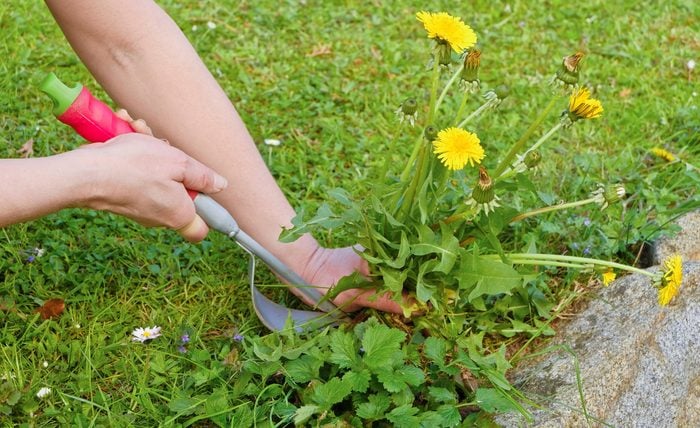When to keep and when to remove some of the fastest-growing U.S. weeds. While some weeds are a nuisance, some feed people and pollinators.
12 Most Common Weeds and How To Get Rid of Them
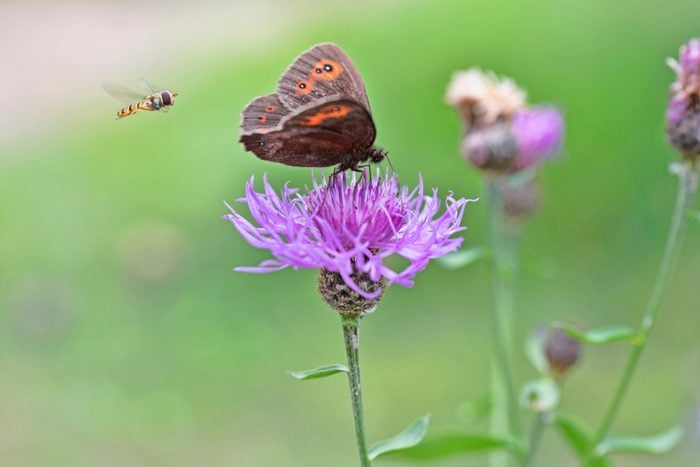
Canada Thistle (Cirsium arvense)
Canada thistle can sprout from its abundant seeds and underground roots which can spread 15 feet wide. Seeds may live for 20 years in the soil.
How to get rid of Canadian thistle
Canadian thistle is resistant to some single-action herbicides, so the best strategy is to exhaust the roots over time, according to Cornell University.
Remove as much as possible early in the season by digging. Then shade out the roots with lush crops like alfalfa or winter wheat.
How to prevent Canadian thistle
Canadian thistle may take repeated efforts to eradicate. “Repeated tillage and mowing have also been used with some success,” Gray says. “For small infestations, a combination of repeated digging, close monitoring for new plants and heavy mulching may be effective.”

Dandelion (Taraxacum officinale)
Dandelion may be the most easily recognized flowering weeds, but it has some interesting culinary and craft uses. It can be a nutrient-packed green in salads, a natural dye, and even go into making dandelion wine. (I’ve done this. It makes a sweet, syrupy cordial that I think would be delicious on ice cream!)
How to get rid of dandelions
“For every dandelion that is uprooted, development of an average of 15,000 seeds is prevented,” says Pfeiffer.
Because perennial dandelions are tap-rooted, Pfeiffer says, “removing the entire root is optimal. They can readily sprout from root fragments left in the ground.”
Dig down deep with a hori-hori knife, hand scythe or spade fork before pulling. It’s easiest and most effective in spring, when the soil is damp and before flowers form.
How to prevent dandelions
It may be fun to blow those downy seed heads to the wind, but each flower produces 200 seeds. Instead, Pfeiffer says, plant your beds thickly and overseed patchy lawns to discourage seeds from forming, and dig any you’ve missed.
Pfeiffer does not recommend “contact sprays,” even organic ones like vinegar, soap and botanical oil concoctions. “They may control small plants,” she says, “but are not as effective on older plants with extensive root systems.”
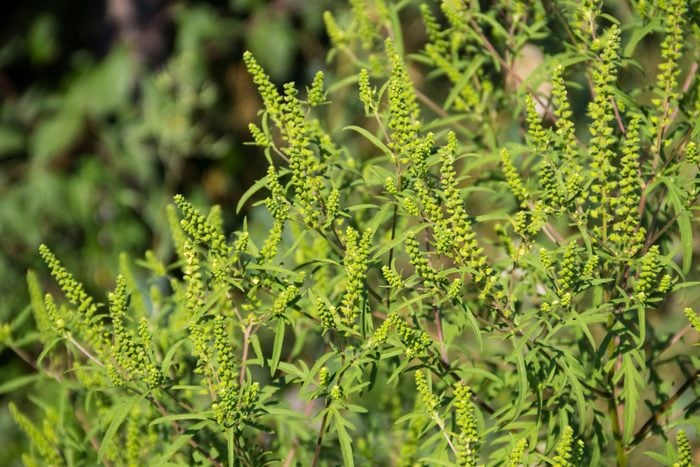
Common Ragweed (Ambrosia artemisiifolia)
Although perennial goldenrod (Solidago canadensis), which has similar yellow flowers, often gets mistakenly blamed, common ragweed is the true culprit of late-summer allergies. It can grow six feet tall if unchecked. Its seeds can stay viable underground for years.
How to get rid of ragweed
“Small invasions of annual ragweed are easily controlled by pulling or hoeing,” says Gray.
How to prevent ragweed
For larger patches, Gray recommends repeated mowing or cutting. Cornell University also suggests hoeing small seedlings early in the season.
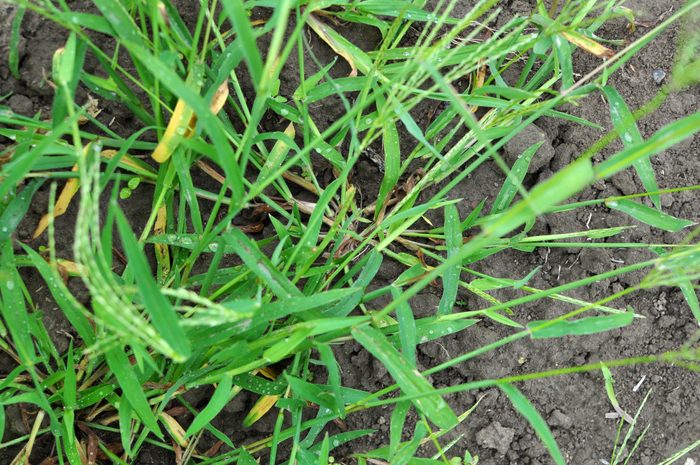
Large or Hairy Crabgrass (Digitaria sanguinalis )
This ubiquitous weed is commonly found in lawns and disturbed open patches of soil. Warm-season crabgrass thrives in hotter weather, just as cool-season turfgrasses struggle to stay hydrated.
How to get rid of crabgrass
Because the seeds are so prolific and long-lasting, controlling crabgrass can take several growing seasons. The main goal is shrinking the seed population.
If you use herbicides, timing is key, according to the University of Massachusetts at Amherst Extension Service. It recommends applying preemergent herbicides when soil temperature is 55 degrees for five days and before crabgrass shows. Apply postemergent products while crabgrass shows two to five leaves.
“For larger patches, burning can be effective where practicable,” Gray says.
“Heavy mulch for a couple of seasons will knock back the population. Smaller invasions can be hand-pulled, hoed or dug out, preferably before seed set and when the soil is moist. Follow with thick mulch and monitor for new seedlings.”
How to prevent crabgrass
The UMass Extension program suggests two ways to tip the scales in your lawn or garden’s favor versus crabgrass. First, water deeply and less frequently. Second, set your mower higher (two or three inches).
These steps will encourage your preferred plants to put down deeper, more competitive roots and shade out new crabgrass seedlings.
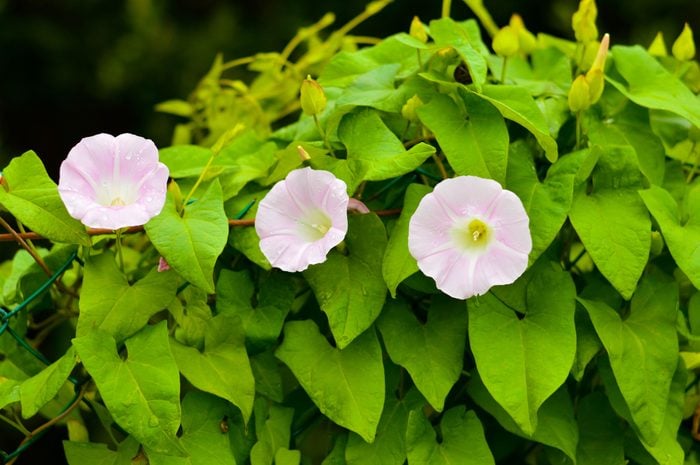
Field Bindweed/Perennial Morning Glory (Convolvulus arvensis)
This deciduous perennial is the rampaging look-alike to the well-behaved annual, morning-glory vine. It spreads by abundant numbers of seeds and regrowth from root fragments.
How to get rid of field bindweed
Dig up as much of the fleshy roots as possible, Pfeiffer says, getting the horizontally spreading roots too. This is most easily done when shoots are just emerging in spring or in fall as the leaves are dying back. She recommends disposing of the vines in the trash because your home compost pile will not be hot enough to kill the seeds.
It’s important to remove any vines growing onto, over and into your shrubs and other perennials so they don’t get smothered. Gray doesn’t recommend contact sprays of any kind because they’re likely to damage surrounding plants. She notes glyphosphate, the ingredient in Roundup, caused stunted leaf growth on azaleas, blueberries, and other shrubs a year after the product was used near them.
Gray adds “solarization” with black plastic can be effective if done for several years. But it will also deaden the life of the soil, so it’s not ideal.
How to prevent field bindweed
Mowing or cutting the foliage at ground level repeatedly over the season will weaken the plants over time, Pfeiffer says. A deep mulch of bare soil in April can slow the growth of seedlings, and cutting off flowers before they set seed will prevent new generations.
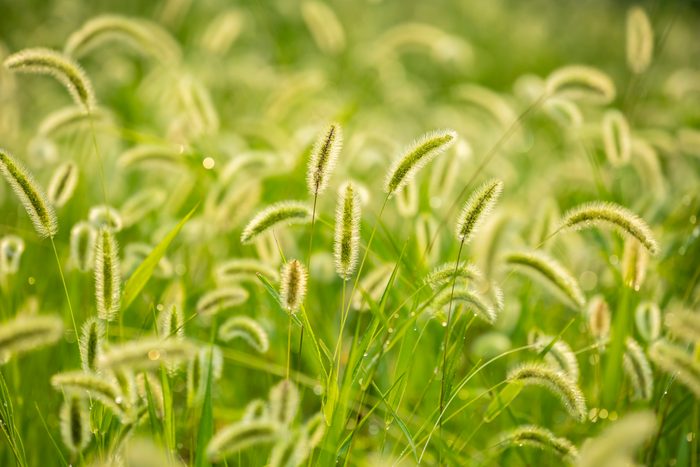
Foxtail (Setaria spp.)
Several grass species in the Poaceae family have invaded lawns, urban planting strips and other disturbed patches of ground in the United States. Top culprits are yellow foxtail (Setaria pumila) and green foxtail (Setaria viridis). Their seed heads travel far and wide, hitchhiking on shoes, animals and garden tools, according to Pennsylvania State Extension Service.
Keep your dog away from foxtails blooming in summer. If eaten or caught on the skin, the spiky seed heads can become lodged, causing infection or difficulty breathing.
How to get rid of foxtail
“If only a few foxtail plants are infesting a lawn, they can be removed by hand pulling or by using a trowel,” according to Penn State Extension.
How to prevent foxtail
Again, a healthy lawn allows fewer weeds. Says Penn State Extension: “Improving turf density through fertilization, irrigation during drought conditions and the use of turfgrasses well-adapted to site conditions will help reduce infestations of foxtail.”
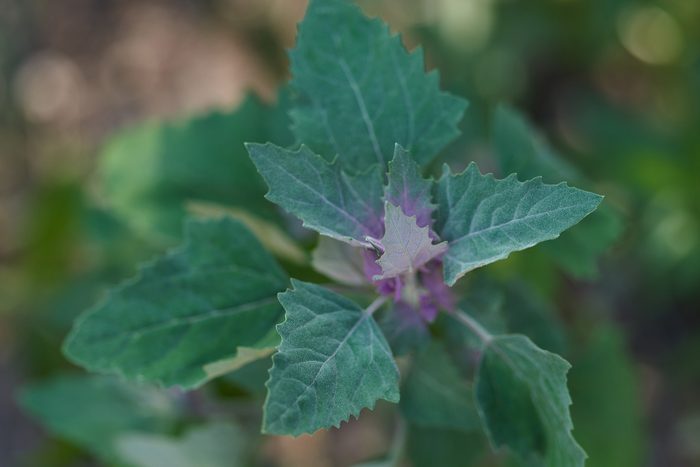
Lambsquarters/Pigweed (Chenopodium album)
This Quinoa relative, cultivated for medicine and food in India for its vitamin-rich leaves, is said to taste like spinach. According to the Brooklyn (N.Y.) Botanic Garden, “The long taproot extends deep into the soil, drawing water and nutrients closer to the surface and allowing more shallow-rooted plants access as well.”
It can be toxic to livestock in quantity, unfortunately. Its standout silver leaves make it easy to spot. However, once it appears in your yard, you’ll see it’s much easier to grow than spinach whether you welcome it or not.
“Some champion plants produce as many as 70,000 seeds,” says Gray. “The seeds can remain viable in the soil for decades.”
How to get rid of lambsquarters
“For small invasions in gardens, hand-pulling is usually the easiest thing,” says Gray. “Pull or hoe when the soil is moist, and the taproots are shallow and easy to dislodge.”
Now resistant to several herbicides after agricultural use, repeated close mowing is one of your best strategies in a large area, Gray says.
How to prevent lambsquarters
Once weeded, mulch deeply and be vigilant about scanning for seedlings, says Gray.
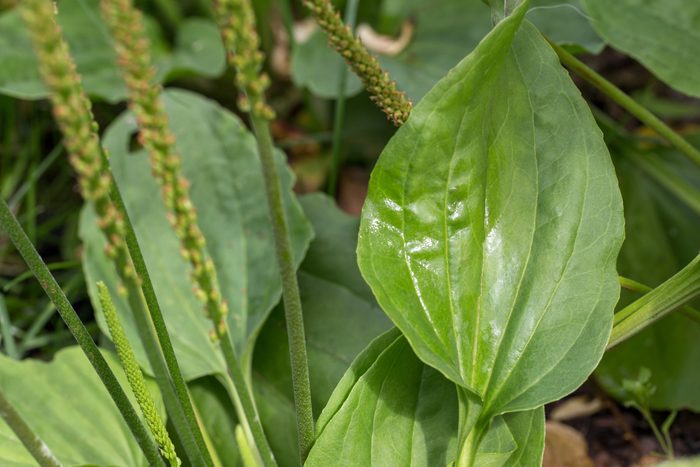
Plantain (Plantago major)
Settlers introduced this perennial plant. Because it kept popping up in places disturbed by human digging, native Americans came to call it “white man’s footprint.”
According to the North Carolina State Extension Service, its nutritious leaves — rich in calcium and vitamins A, C and K — make it popular for foraging and kitchen gardens. Plus, its ability to break up compacted soil comes in handy for aerating. Leaves were also used medicinally for treating bites and stings.
Act fast if it’s growing where you don’t want it. Each plant can produce up to 20,000 seeds.
How to get rid of plantain
University of California’s agriculture department suggests digging mature plants before they flower and set seed. You will likely need several passes through your bed each season. Also, remember to clean your tools before moving onto another bed!
How to prevent plantain
Plantain’s low basal leaves resist mowing. Pfeiffer says persistent digging and shading it out with other plants and/or thick mulch are your best defenses.
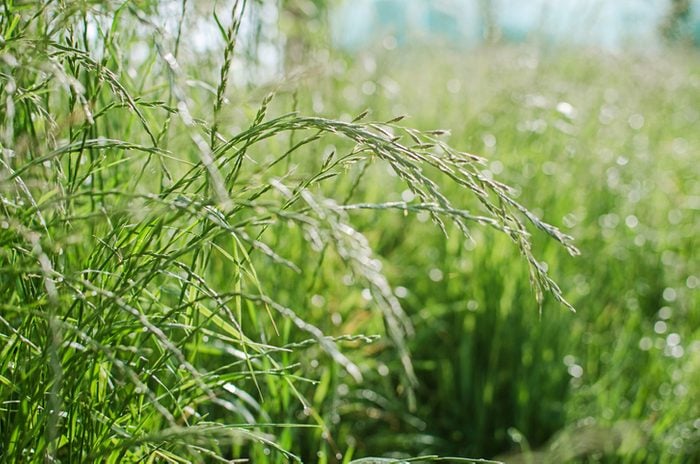
Quack Grass/Couch Grass/Creeping Wild Rye (Elymus repens)
The rhizomes (i.e. underground stems that form new plants) of this cool-season, sod-forming grass extend as far as eight inches deep and 24 inches horizontally. “A plant may send out over 100 distinct, branched rhizomes, with hundreds of potential buds for new plants,” Gray says. “It can spread at a rate of 10 feet annually.”
To make matters worse, Purdue University’s Turfgrass Program says quack grass is allelopathic, meaning it releases chemicals which limit the growth of other plants.
How to get rid of quack grass
“For the home gardener, quack grass can be a challenge when it insinuates its rhizomes into lawn or desirable garden plants,” says Gray. “Hand-pull, hoe and dig to remove as many of the rhizomes as possible.”
How to prevent quack grass
Follow up your weeding session with heavy mulch, then monitor for resurgences, Gray says. Once the area is clear, consider adding low-growing ground covers that will retain moisture and shade out any new interlopers.
According to the Purdue program, a dense, healthy lawn is the best defense against quack grass. If you’re reestablishing a turf area with previous quack grass issues, laying sod may be a better alternative to seeding.
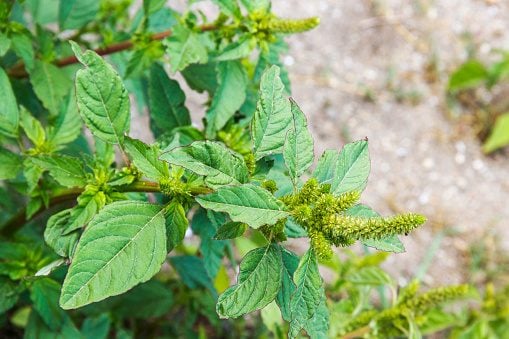
Red-Root Pigweed (Amaranthus retroflexus)
According to Gray, this is “a common weed of agricultural fields, gardens roadsides, and other disturbed sites in open, sunny areas.”
A single plant may produce from 35,000 to more than 100,000 seeds. “In farming, it can outcompete crops, causing major losses in grain, legume and vegetable crops,” Gray says. While edible, it can contain excess amounts of nitrates, causing significant livestock poisoning risk in quantity.
How to get rid of red-root pigweed
“Small infestations are easy to remove by hoeing or hand-pulling,” Gray says.
How to prevent red-root pigweed
Simply mowing early in the season can reduce seed dispersal, says Gray.
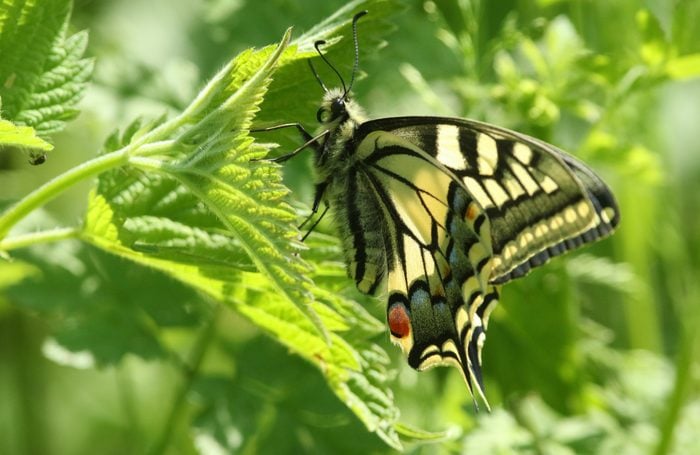
Stinging Nettle (Urtica dioica)
Believe it or not, despite this plant’s itch-inducing “sting,” many people (including me) harvest the young leaves of this nutritious Western U.S. native perennial each spring.
Wear gloves and protective clothing and bring a deep bag or basket that stands up straight to transport the leaves. Cooking completely instantly neutralizes the nettle’s sting. Its earthy umami flavor makes it a coveted spring pesto ingredient in top-tier restaurants, while nettle tea is said to have immune-boosting properties.
However, if you have young children or it’s growing near a path, you may want to remove it.
How to get rid of stinging nettle
“It can be controlled by hand-pulling very young plants, digging out with as much rhizome as possible when they are more established or repeatedly cutting [carefully] to the ground,” Gray says.
How to prevent stinging nettle
Close mowing before flowering can prevent the spread of seed, says the University of California Agriculture Integrated Pest Management Program. Take care not to overturn the soil often, which can help the rhizomes proliferate.
Because nettles prefer moist soil, increasing the drainage or reducing watering to the area may discourage infiltrations.
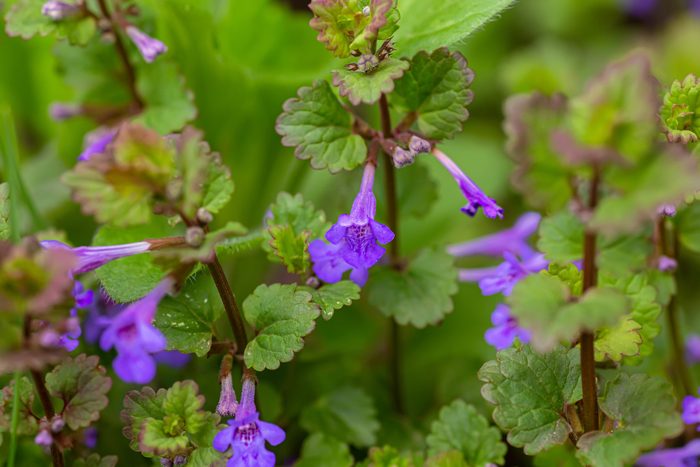
Creeping Charlie/Ground Ivy (Glechoma hederacea)
Gray says the common name Creeping Charlie can apply to at least two unrelated species. She says this herbaceous perennial “proliferates aggressively by branched [stolons] — above-ground runners — up to seven feet long.” Fun fact: Its variegated sibling is a popular “spiller” for container combinations.
How to get rid of Creeping Charlie
“Mowing, cutting and burning have all proven ineffective, even in combination, due to the persistence of stolons,” says Gray.
“Even with herbicides, repeated application, monitoring may be required, due to rapid regeneration of any surviving stolon fragments. Small infestations can be hand-pulled and dug out, but it is imperative to remove every scrap of root and stolon.”
How to prevent Creeping Charlie
The University of Wisconsin Extension Service recommends growing lush turf or ground covers to prevent Creeping Charlie from gaining a foothold. Try overseeding your lawn, regularly mowing to a height of two to three inches, watering deeply and infrequently, and growing the right turfgrass for your conditions.





















